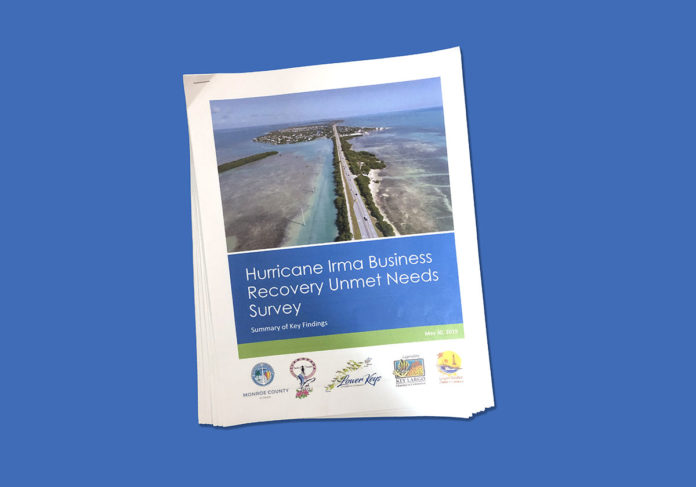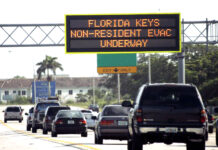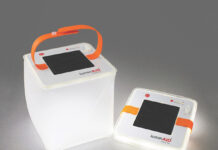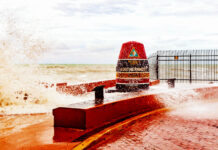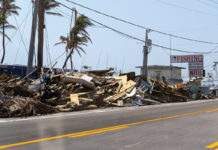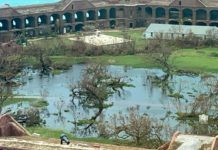A roll-out of new post-hurricane business recovery programs can best be named Rebuild Florida, phase 2. On June 3, Monroe County brought together stakeholders to learn about help available to Keys business owners from federal and state funds, and to brainstorm ideas that would make the Keys economy more resilient the next time a storm hits the Keys.
Those in attendance expressed some skepticism about the new program, given the results so far of the initial phase of Rebuild Florida. (See sidebar.)
The audience received updates on four different programs available during the second phase. The Florida Wildlife Commission’s C.J. Sweetman told the audience about $44.6 million that will be available for marine fisheries assistance. The state Department of Economic Opportunity’s Reginald Dixon explained updates on the $60 million business recovery grant program, $20 million workforce training program, and the $85 million infrastructure repair and mitigation activities.
There is a third pot of money, phase 3, coming: $791 million available in Florida for infrastructure and mitigation purposes. Most agree that municipalities are the natural fit for the final program.
The funds are not available yet. Dixon guessed it would be October before the grant documentation is finalized for phase 2, application period opened, and applicants reviewed.
Are program funds necessary two years after a natural disaster? The businesses that needed help have already gone out of business and are no longer eligible. That leaves businesses that have already demonstrated their ability to survive; what is owed to them?
Both Dixon and Monroe County’s Christine Hurley addressed the issue.
Dixon said the grants focus on long-term recovery and resiliency after all other assistance has been exhausted, including private insurance and other forms of federal assistance.
“When we were entering Hurricane Recovery after Hurricane Irma, everyone thought everything had to get done immediately,” said Hurley, assistant county administrator over the building, planning and code departments. “But there is a different philosophical view, and that is that people have to be responsible for their own well being, before they spend public money.”
One of the ways the Business Recovery Grant Program can be used is to pay for lost equipment and inventory. Daniel Samess, of the Marathon Chamber of Commerce, said that a theoretical business owner who had to replace an expensive generator after the storm could provide a receipt and request BRGP funds.
Dixon said he’s investigating what portion of the Florida Keys Community College’s apprenticeship program — to train new skilled workers in construction, plumbing and electrical — would qualify for the Workforce Recovery Training Program. The Marine Fisheries Disaster Supplemental Assistance presumably could be used to pay for lost traps, and possibly lost income.
Later in the day, the workshop participants broke into small groups. Quickly, the conversation turned to ways to modify the current programs, or prepare for the future.
Helene Wetherington, the workshop organizer and Monroe County Disaster Recovery director, said the group had several ideas: increasing the amount of financial assistance above $50,000; in addition to funds to replace lost equipment and inventory, adding the ability to make structural repairs; and more work on the loan program to come up with more favorable terms for Keys businesses.
“Participating in the activities that took place in this room today was an eye-opening experience,” said Wetherington. “Almost two years after Hurricane Irma, our businesses still lack financial resources, and we need to continue to make funding for Monroe County businesses a priority.”
“There is one silver lining to this,” said Julie Dennis, a disaster consultant. “Every time Congress gives funding for a disaster, there are brand-new rules. It’s not efficient. This is a chance to get ahead and come up with something more streamlined.”
Rebuild Florida, phase 1
In September 2018, with much fanfare, Gov. Rick Scott rolled out a program called Rebuild Florida. Funded with $616 million from the U.S. Department of Housing and Urban Development for Hurricane Irma victims in Florida, the first phase of the program set aside $90 million JUST for the Florida Keys. About $50 million would go to repair, rebuild and renovate private homes — whether owned or rented — of the most vulnerable Keys residents (households with elderly, young children, low-income, etc.) The other $40 million would be split among programs for construction of rentals for workforce affordable housing, land acquisition for affordable housing, and voluntary home buyouts.
Fast forward almost a year and, one home project has been completed in Central Florida, far from Hurricane Irma’s ground zero on Cudjoe Key.
“We just finished the first house in Lake Wales,” said Reginald Dixon, director of disaster recovery in the state Department of Economic Opportunity. “And we have pushed four houses in Monroe County to the awards stage.”
According to Rebuild Florida officials, 1,250 households in the Keys have registered for the program. Of those, 533 have been “invited to apply” to the program. Frustration is mounting.
“Rebuild Florida has been hyped and hyped and hyped, and not one project done in the Keys,” said former Monroe County Commissioner George Neugent.
Homeowners will not receive funds directly. Rebuild Florida will manage and complete the construction process for the repair or reconstruction of damaged homes on behalf of eligible homeowners. It will use an approved list of contractors licensed in Florida, but not necessarily Monroe County, Dixon said.
BUSINESS SURVEY RESULTS
The results of Monroe County’s Unmet Needs Survey were unveiled on June 3 at a long-term recovery meeting in Marathon. During May, county staff sought voluntary responses from businesses in Monroe County at the behest of the state Department of Economic Opportunity, intended to guide future recovery. The county collected 85 responses from businesses located along the island chain, from Key West to the Upper Keys. (The county estimates about 4,500 “employment establishments” in the same area, although there are many more occupational licenses for self-employed businessmen and women.) Here are some of the key findings:
- Business owners said “overwhelmingly” that lack of skilled workers and workforce housing is the major issue they face. However, respondents also said they had either more or the same number of employees as they did prior to Hurricane Irma.
- 46% of business owners report still having physical damage.
- 54% of businesses said they were uninsured or under-insured.
- 47% of businesses reported they were currently stable; 22% said they were in decline.
FEEDBACK
Daniel Samess, Marathon Chamber of Commerce:
“I will update members regarding timelines from DEO, specifically regarding the business recovery grant program. They are looking to launch that 60 days from now, potentially. I will also keep them abreast of the loan programs available from the Small Business Development Center.”
Heather Carruthers, Monroe County Commissioner of District 3 (Key West):
“Staff was hoping to see more specific recovery projects, thinking about things like beautifying Key West and creating arts districts. We need more flexibility (spending grant money). I say that for the Keys specifically, but also the entire state. We are diverse.”
Dave Turner, Lower Keys Chamber of Commerce:
“My message to members is this: I will keep fighting hard and going to all the meetings. I don’t know if this is going to happen, but if it does, great; I will help all our members fill out the paperwork and hand deliver it to Tallahassee.”
Judy Hull, Islamorada Chamber of Commerce:
“I’m going to compartmentalize the different grants, and explain the progams to different segments of my membership. I’m going to deal with it more individually. For example, the FWC grant is a good fit for my boat captains.”















